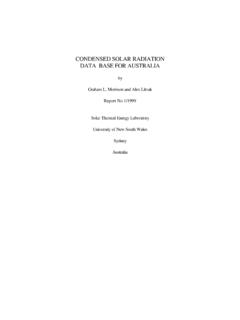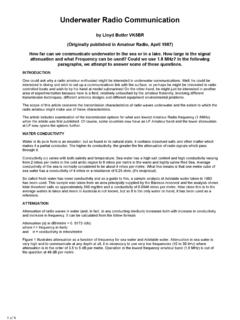Transcription of A Simple Regenerative VLF-LF Receiver
1 1 of 6A Simple RegenerativeVLF-LF Receiver by Lloyd Butler VK5BR(Originally published in "Amateur Radio", January, 1992 )IntroductionIn an earlier issue of of Amateur Radio, I described a superheterodyne Receiver for the VLF-LF bands, This was followed by a series ofarticles on front end tuning and loop aerials for these bands. Now I will describe a more basic form of VLF-LF earlier days of radio, quite successful reception of low frequency radio waves was achieved with a single valve stage as a Regenerative amplifier-detector and a valve audio amplifier. At low frequencies, a modest value of Q factor in a single tuned circuit achieved workable station selectivity which was further improved by regeneration to increase the effective Q and further reduce the circuit bandwidth. Furthermore, by increasing the regeneration to the point of oscillation, a beat frequency was produced to enable reception of CW signals (or radio teletype if used today).
2 As the voltage magnification of a tuned circuit is equal to Q, the regeneration also improved the sensitivity of the Receiver well beyond that achievable with its single RF stage as a straight Receiver I will describe is based on the above principles but is designed around more modern solid state amplifier packages. It tunesbetween 10kHz and 430kHz with quite reasonable selectivity. A selectable audio bandpass filter is included to improve the reception of narrow band signal modes in the VLF DescriptionThe Regenerative RF section of the Receiver is shown in figure 1a. Figure 1a: VLF-LF Receiver , Regenerative RF SectionThe single tuned circuit is made up of the paralleled sections of 3 gang tuning capacitor C8 and one of the switched inductors L3, L4, L5,or L6. The tuned circuit is connected within the closed loop containing the two amplifiers of an LF353 integrated circuit package. These are JFET amplifiers with a gain-bandwidth product of 4 N1B is connected as a voltage follower which, with it's high input resistance, prevents loading of the tuned circuit thus allowingits high Q.
3 Factor to be realised. Positive feedback, or regeneration,is fed via the inverting input of N1A. The level of feedback is 2 of 6controlled by the setting of the reaction control RV2. The input signal is fed to the non-inverting input of N1A and combined with the regenerated signal within the amplifier. The combined signal is injected into the tuned circuit across C4. The capacitance value of C4 is large by comparison with that of the tuning capacitance and hence the injected signal source resistance has little effect on the circuit Q. The injected signal can be considered to be applied in series with the tuned circuit and whilst its developed voltage across C4 is small, it is multiplied by the circuit Q at the input of loop gain is provided by N1A and with phase reversals at N1A and at the point of injection, the circuit can be made to oscillatewhen the reaction control RV1 is advanced to the critical point. The circuit is different from the accepted method of applying regenerationvia the RF transformer in which one winding is used for the tuned circuit, a second winding for the feedback signal and a third for the input signal.
4 One reason for avoiding this method was to make use of single winding inductors which were on hand. The additional windings would have meant making special transformers for the are also some operational advantages in using the circuit of figure 1A. One problem in coupling an aerial directly into the tunedcircuit is that when regeneration is set for oscillation, the whole thing works as a small transmitter, radiating a signal via the aerial and causing interference to others. Another problem is the changed loading on the tuned circuit for different lengths of aerial and the interaction it causes with the setting of the reaction control. By injecting the input signal and the feedback signal via different inputs of N1A, both these effects are specific components in the circuit require explanation. Diodes Dl and D2 limit the amplitude of oscillation when the circuit is set in the oscillating or beat frequency mode. The curved characteristic of the diodes also give a more gentle slide into oscillatiion when RV2 , when using the input directly connected to a long aerial, I had some problems with local broadcast station pick-up and low frequency power mains generated noise.
5 Components L1 and C2 make up a low pass filter which attenuates signals above 400 kHz andeliminates the broadcast station interference. The mains generated noise was considerably reduced by the addition of R2 across capacitor C4 to limit the impedance of the tuned circuit injection point. Without this addition, the reactance of C4 at very low frequencies became very high, allowing a high level of noise at these frequencies to be injected. High pass filter C1,L2 further attenuates low frequencies below 10kHz. If the Regenerative circuit is preceded by a tuned stage, rather than directly connected to an aerial, filter components C1,L2,L1, C2 can be gain control RV1 is included to reduce the input level on strong signals when the input is driven from a previous RF stage. If the circuit is connected directly to an aerial, the level is lower and RV1 is not D3 and low pass filter C12,R11,C3,R12,C14 form the detector circuit, At very low frequencies (near 10kHz) the RF signal frequency approaches the frequency spectrum of the audio amplifier with a consequent tendency for the whole RF-audio link to become unstable, The second section of filtering, R12,C1, was found necessary to control this There is a small positive bias applied to the detector diode via resistor R8.
6 This shifts the diode operating point further up its characteristic curve to improve the Receiver sensitivity on weak Audio SectionThe detected output is fed to the input of the audio section of the Receiver (figure 1b). Figure 1b: VLF-LF Receiver - Audio SectionDevice N2 is a uA747 dual operational amplifier package. N2A is used as an audio driver which feeds the power amplifier N3. Operationof the audio filter switch SW2 connects in a 800Hz band-pass filter formed by N2B and its associated circuit components. This type of filter, which requires only one amplifier unit, was described by Gilbert Griffith VK3CQ in Pounding Brass, Amateur Radio, February 1989 and credited to Gary Bold ZL1AN in Break In. Using the component values shown in figure 1a, the filter centre frequency is 800Hz with abandwith of 84Hz (as measured). The centre frequency and bandwidth can be altered,if required, by altering the values of R19, R20, C19 & C20.
7 The design formulae for these are included in Gilbert's the high noise level at VLF, the audio filter is a desirable addition to restrict the detected noise when receiving morse or radio teletype signals in the VLF band. To use the filter, the beatfrequency is set to 800Hz. With the Regenerative RF circuit, this is achieved by off-setting the tuning 800Hz from the received signal frequency. In actual fact, there are two tuning positions, one below the signal frequency and one above the signal frequency. You pick the one which gives the least interference from adjacent signals or noise. This characteristic of the Regenerative circuit which gives two 3 of 6tuning positions is very noticeable at VLF. For a 800Hz beat note, the two tuning positions are 1600Hz apart. At a typical frequency of 16kHz, this represents a tuning shift of 10% of the operating speaker is driven by power amplifier type LM380 (N3). This IC is available in either a 14pin version or the smaller 8 pin version.
8 I used the 14 pin version because I happened to have one already wired up with associated components on a board. (In my superhet Receiver , AR Dec 1989, I did in fact use the 8 pin. version).The DC load current for the LM380 swings between 10mA and 150mA, depending on the audio power level. Hence the DC power supplyto the Receiver must be well regulated. The remainder of the Receiver load is only 5mA and this is decoupled from the supply by R14 and C15. Even with this decoupling, instability can occur between the audio and RF sections if the supply regulation is inadequate. The nominal supply voltage is 12 but any voltage between 10 and 15 can be of the Receiver referred to its input was measured in terms of minimum discernible signal level using a calibrated signalgenerator as the source. Below the point of oscillation in the Regenerative circuit, the measurements were carried out with the signal generator carrier modulated with tone at 30%.
9 At the point where oscillation just commenced (the most sensitive state), unmodulated carrier was used to beat with the internal no regeneration, ie the reaction control set to zero, the minimum discernible signal level was found to be around 500 microvolts. With the reaction control set just below the point of oscillation, the figure improved to around 50 microvolts. At the point of oscillation, carrier could be detected at 3 is much the same over the tuning range except that it drops above 300 kHz due to the effect of filter C1-L2. In practical terms,the Receiver detects quite weak signals in the beat frequency mode, For AM signals,the Receiver is less sensitive. It can receive more localised Non-Directional Beacons quite well but requires some RF pre-amplification for weaker 3dB bandwidth was measured at input frequencies of 20kHz, 100kHz and 350kHz. The bandwidth with no regeneration measured 270Hz at 20kHz, , at 100kHz and at 350kHz.
10 This implies a circuit factor of 70 at 20kHz, 38 at 100kHz and 70 at the regeneration to just below the point of oscillation, the bandwidth improved to 12Hz at a centre frequency of 20kHz, 100Hz at 100kHz and 157Hz at 350kHz. The regeneration thus increased the effective Q to 1700 at 20kHZ, 1000 at 100kHz and 2200 at measurement at the point of oscillation was not attempted as this appeared to be rather difficult to resolve. In any case, Ihave already pointed out that, in the beat frequency mode, the tuned circuit is offset from the incoming the beat frequency mode, the Receiver strongly receives VLF-LF stations such as Omega around 11 to 13kHz, the North West Capeon and Belconnen Navy Station on 44kHz. However, there is some limitation on adjacent channel rejection. Firstly there are twosignal frequencies which can beat with the internal oscillation, one above and one below the oscillation frequency. If one of these is the desired signal frequency, the other could correspond to an adjacent operational signal frequency.





